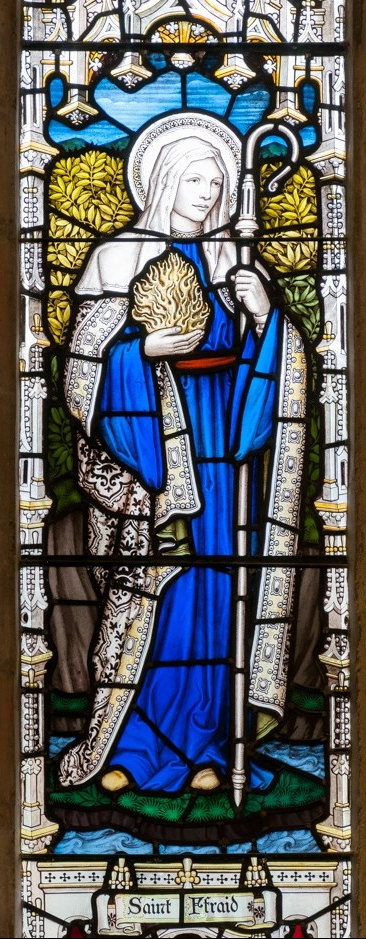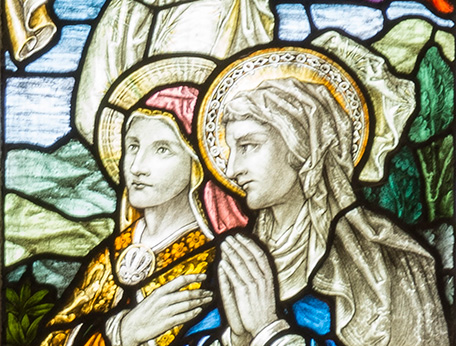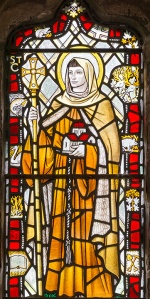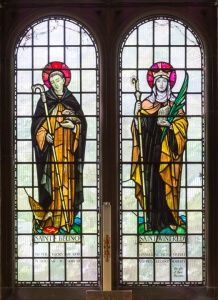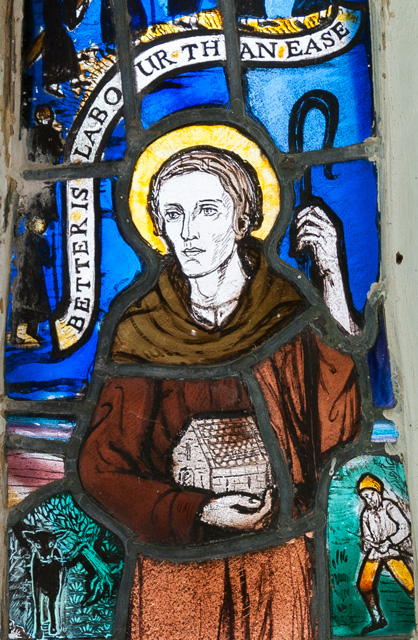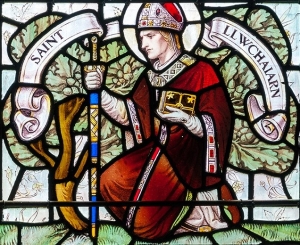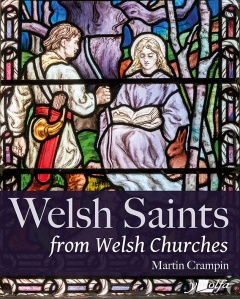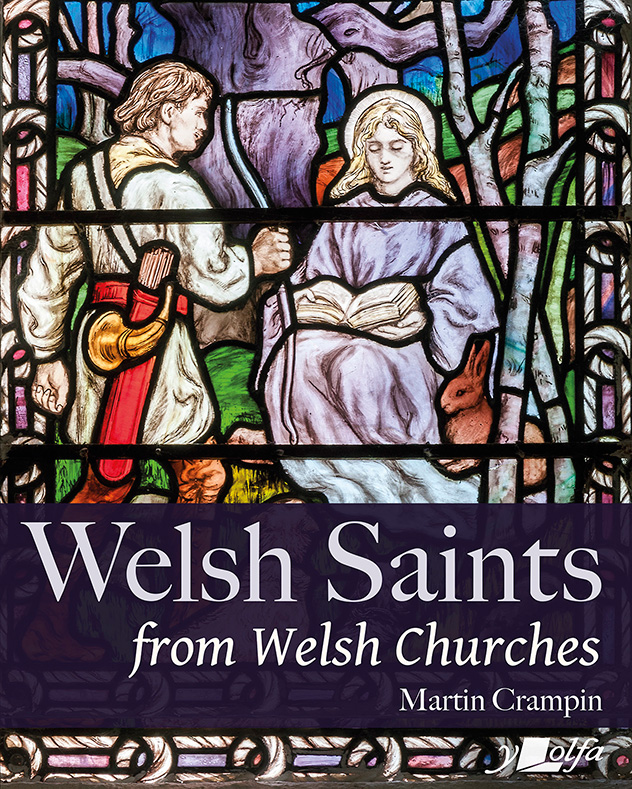Home » Posts tagged 'Welsh Saints from Welsh Churches'
Tag Archives: Welsh Saints from Welsh Churches
Ports, Past and Present
Over the last couple of years I’ve been working part-time on the Ports, Past and Present project, which was funded by the European Regional Development Fund through the Ireland Wales Co-operation Programme to work with the communities around the five ferry ports that connect Wales with Ireland.
The project has been exploring the heritage of these places to promote tourism and deepen a sense of shared identities connected by the Irish Sea. In the last year of the project I led a couple of guided walks to see the stained glass in the towns, and gave talks on stained glass and medieval stories of the saints who journeyed across the sea.
The stained glass sometimes embodies or visualises the links between the two countries, such as the image of St Ffraid, or Brigid, in the east window of the church at Trearddur Bay, near Holyhead, travelling across the sea to Wales on a turf of grass. In the medieval church in Holyhead, the east window by C.E. Kempe was given in memory of William Watson, the managing director of the City of Dublin Steam Packet Company, and two windows by the Dublin firm of Clarke’s were made for the Catholic church in Fishguard.
Some of these stories of the saints with associated imagery can be found in my book Welsh Saints from Welsh Churches, and I have written a series of short pieces for the Ports, Past and Present website, which are presented as an online tour, ‘Saints and Stained Glass across the Sea’.
In the closing months of the project I also produced small books on the stained glass in and around Holyhead and Fishguard.
Attributing Welsh Saints II: Saints by A.L. Moore
Some of the images of saints included in Welsh Saints from Welsh Churches are from churches that are now closed. Where relevant it seemed important to make space for windows whose future is now uncertain, and make sense of windows that may not be available to study in the future.
I visited the Church of St Catherine in Old Colwyn some years ago, by which the time the church had been closed for some time and was inevitably in a rather sorry state. Stained glass at the church consisted of a rather lovely set of decorative windows along the north and south walls and a large pictorial window in the east wall of the chancel. Large paintings and beautiful stencilled work had also been added to the chancel, presumably in the 1880s or 90s.
The north and south nave windows were made in the 1880s by Cox, Sons, Buckley & Co. (one of which is signed), and it seemed possible that the donor of the east window went to the same firm for this window. Although the firm of Cox & Son appears to have been prolific, too little attributed work by the firm has been published to attribute windows to the studio with much certainty. In the 1870s they boasted that their windows were made by ‘eminent church designers’, and this is likely to have made their windows difficult to attribute if the designers’ individual approach to draughtsmanship as well as composition was retained in the manufacture of the windows by the studio.
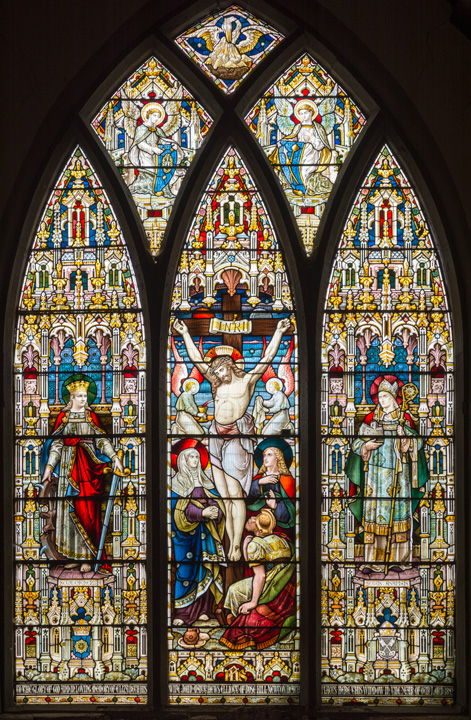
Cox and Sons joined with Buckley & Co. in the 1880s, which was taken over by T.F. Curtis in 1893. I have come across several windows of the 1890s signed by Cox, Sons, Buckley & Co., and although these have a recognisable style, they may not be of much help in identifying their work before that date. I was unable to spot any recognisable similarities in the decorative style of the nave windows with the surrounding decorative work of the east window of St Catherine’s in Old Colwyn, which is dated 1892. The window has a Crucifixion scene at the centre, with figures of St Catherine and St Asaph, patron of the diocese at either side. The face of Catherine has the look of a portrait, presumably that of Elizabeth Matthews Elliott – in whose memory her husband, John Matthews Elliott, commissioned the window. The couple lived in Newton Heath, now part of Manchester, and were no doubt wealthy holidaymakers to the North Wales coast.
As I was unsure who made the window, I continued to look for other possible makers that might have been responsible for it, but for a long time I was unable to come up with any convincing suggestions. However, while completing and designing the book, the work of A.L. Moore attracted my attention because the studio (as A.L. Moore and Son) made a small number windows of Welsh saints that I had been looking at, including a war memorial window that included St David at Ferryside (1901, not included in the book), a window of St Teilo at Pontarddulais (1905), and a later window of St Patrick and St Asaph at Machynlleth (1921).
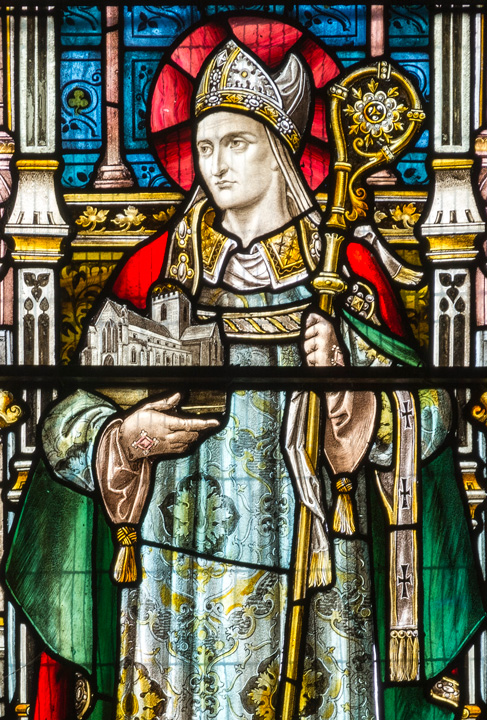
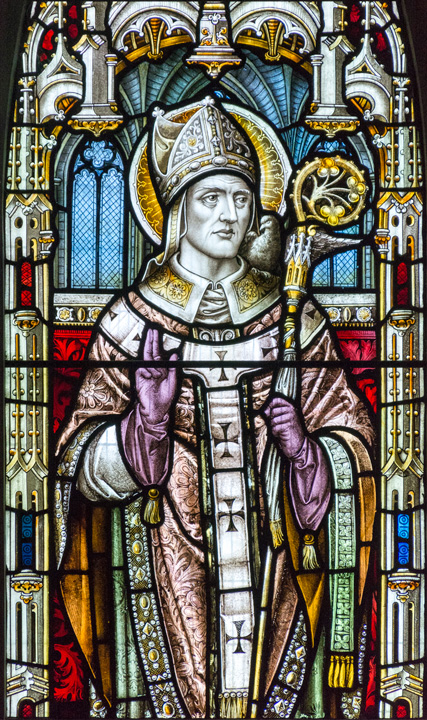
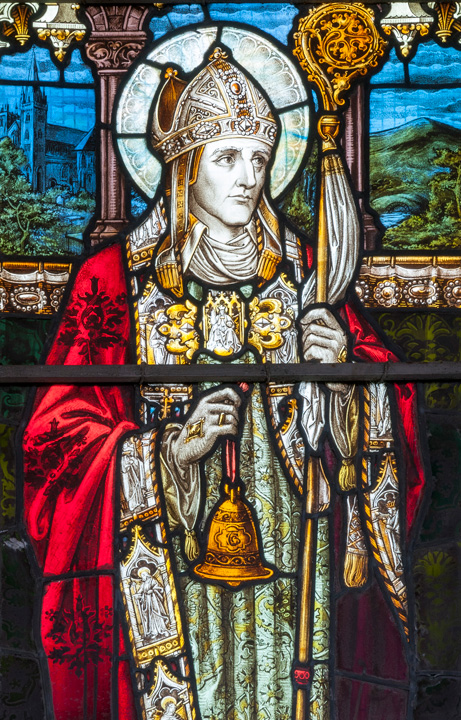
A distinctive treatment of the lips and a similar, rather pallid, painting of the faces is shared by the figures in the windows at Ferryside and Pontarddulais, and the figures all have a lot of delicate patterning on the robes. The faces of two of the women at the empty tomb in the large east window by the firm at Gorseinon (1913, also dedicated to St Catherine) are also reminiscent of Asaph in the Old Colwyn window.
Curiously, the centre light and the painting of the face of Christ at Old Colwyn looks rather different to the rendering of the saints at the sides, and the more detailed curls of his hair can be found in other windows made by Moore in the late 1880s. A set of windows that I attributed to Moore can be found at Penally, and I included one of them in Stained Glass from Welsh Churches, having initially been led to believe that they were by Jones & Willis. These were difficult to attribute as the paint on many of them had faded – a fate shared by another large window of a similar date by them in Pembrokeshire at Prendergast – and poor restoration has replaced some of the original painting. However, a monogram identified the maker as Moore, and some of the surviving heads share this more detailed and less anodyne style of glass painting.
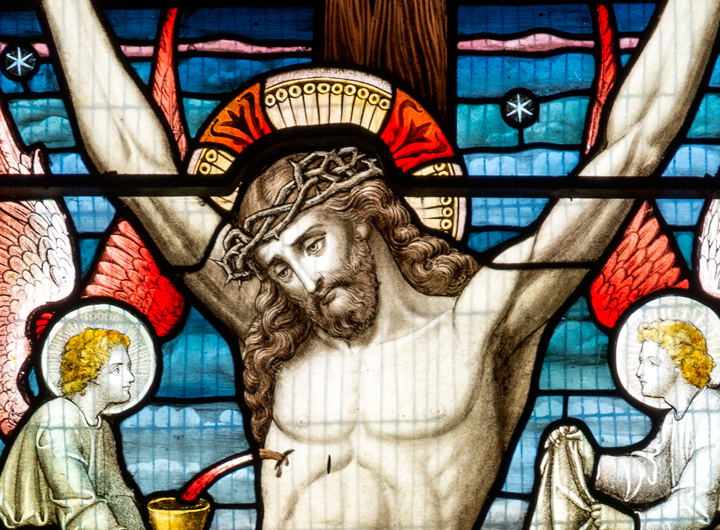
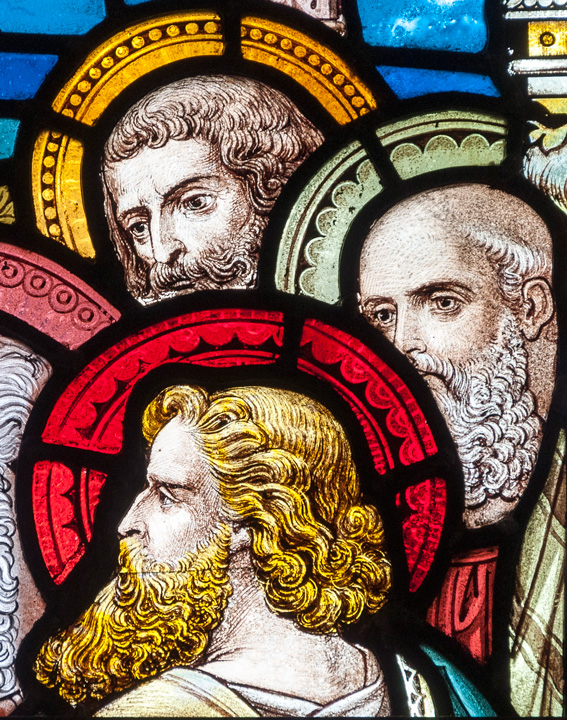
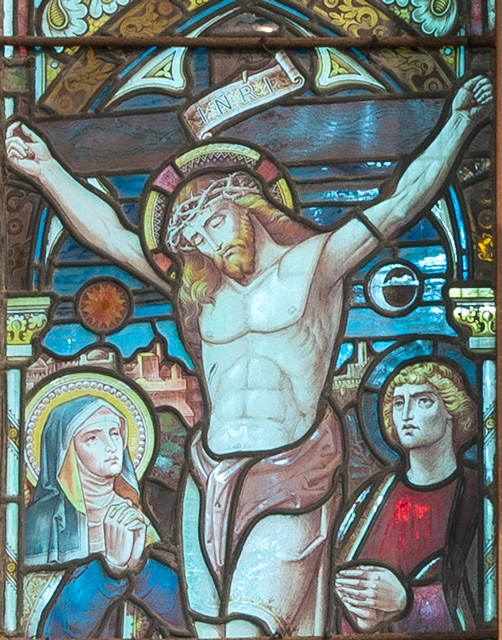
The different styles certainly complicate an attribution of the east window at St Catherine’s, Old Colwyn, to A.L. Moore, and a further window by the firm (The Buildings of Wales volume for Powys says that it is signed, but I missed the signature or mark) of an uncertain date at Llanyre appears to be in an earlier style closer to the Penally windows. Whatever the date, the figure of Christ at Llanyre is very close to that used at Old Colwyn, even accounting for figures of Crucified Christ often being so conventionalised.
Arthur Louis Moore sometimes signed his work as A.L. Moore & Co. before his son, Charles Eustace, became a partner and the firm became known as A.L. Moore & Son, and then A.L. and C.E. Moore from the 1920s. At all stages there were no doubt a number of designers, cartoonists, glass painters and other assistants, and so a variation in the work of the firm is not surprising.
During the process of writing this piece I remembered another window that I had recorded by A.L. Moore at Llantilio Pertholey in Monmouthshire. Having checked my photographs of this window I saw that not only did it form something of a stylistic bridge from the east window of St Catherine’s, Old Colwyn, to others by the firm of A.L. Moore, it also included Welsh saints that didn’t find a place in Welsh Saints from Welsh Churches. St Teilo, patron of the church, and St David stand at the far left and right of the window.
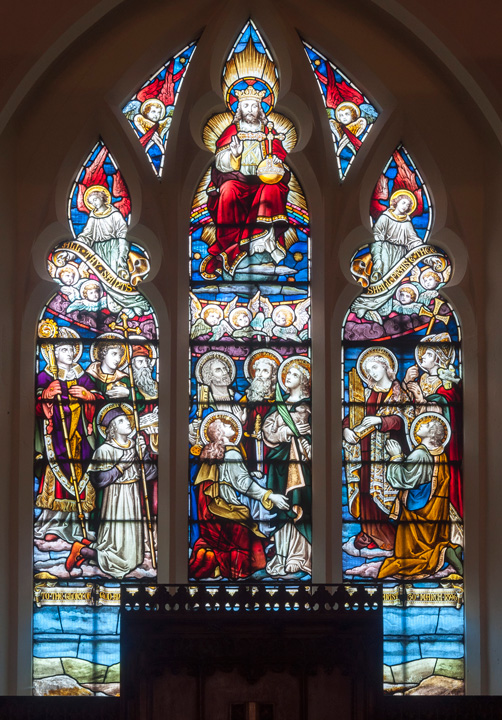
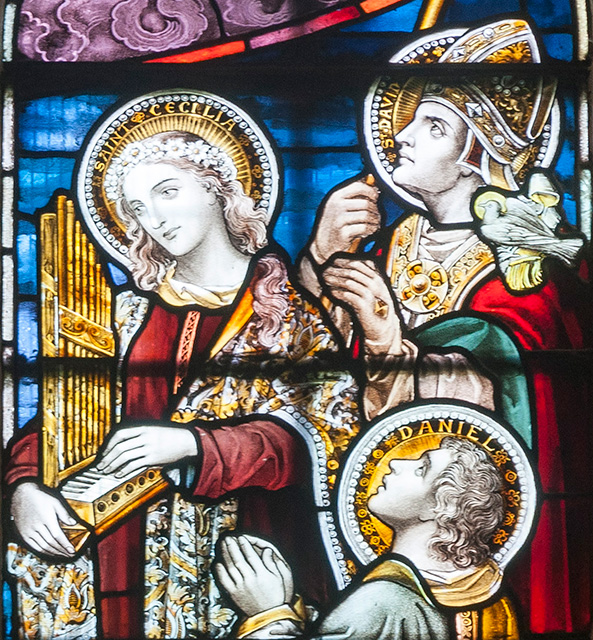
It was made in 1896, so is closer in date to the window at Old Colwyn, and is suggestive of the move towards the paler rendering of faces and has the pursed lips of the figure of Asaph, and of David at Ferryside and Teilo at Pontarddulais. The window at Llantilio Pertholey is also placed in the east wall of the chancel, and the overall design is livelier, with the figures filling the whole aperture of the window without the recourse to the extensive Gothic Revival canopies that can be found so often in church windows of the nineteenth century. The saints are helpfully labelled on their haloes to aid their identification.
Attributing Welsh Saints I
Establishing some of the basic facts about stained glass windows can be surprisingly troublesome. I have written previously on this blog about the difficulties of attributing windows to makers and designers and it is sometimes a challenge to provide dates for windows as well.
As work on Welsh Saints from Welsh Churches came to a conclusion last year I was left with a small number of windows that I wanted to publish but was unable to attribute, which I found very frustrating. A few that I decided to include in the book remain anonymous works but there were others that I managed to attribute by various means prior to publication.
These included a lovely window of St Cadog from the little church at Llanddetty, with details from the Life of Cadog around the border. I found this window by chance when I visited the church, It was not mentioned in the Buildings of Wales volume for Powys and, having found it, I couldn’t trace a faculty for it. Judging by the style of the window, I was initially sure that it was by Powell & Sons, only to find that it was not included in the provisional list of windows by the firm compiled by Dennis Hadley.
I began to wonder whether the window might be by one of Powell’s designers and considered Carl Edwards, who became their chief designer in the 1940s but left the firm in the 1950s. It was not on the list of his works published by Tony Benyon, but after I got in touch with him, he thought that the window could well have been designed and made by Edwards, around the time that he parted company with the firm.
There were hitherto only two places where Edwards’ work could be found in Wales, with a window by him at St Davids Cathedral and a set of small windows that he made not very far from Llanddetty at Llyswen. Looking at the window again more recently, Tony Benyon was more doubtful that it was by Edwards. It looks more like the many windows made by Powell’s in the immediate post-war period than those made independently by Carl Edwards for Llyswen or St Davids, although there are some parallels. Hopefully new evidence on the designer and maker of the window will come to light.
A couple of windows of a similar date at Holywell had also puzzled me. A lovely window in the Anglican church adjacent to the medieval well chapel featured both Beuno and Gwenfrewy (Winefride), and although it had no dates on it, a little research into the family history of those who gave the window established that it was probably made at some time in the 1950s. As with the window at Llanddetty, I haven’t seen any references to the window in any publication, and the church had no information about it. Even Malcolm Seaborne’s listings of stained glass in Flintshire omits it, presumably because he could find no information about it.
I tentatively attributed the window to Goddard & Gibbs although I had been unable to find many windows of a similar date and style by the firm. Having asked a couple of other researchers, Christopher Parkinson kindly shared examples of their work that he had recorded in England, and some of these windows demonstrated a few similarities. The firm made a window not far away from Holywell at Whitford, and combined with these stylistic tendencies there seemed to be a strong possibility that they had made the Holywell window as well. The window at Whitford is later and in a more modern style, mirroring the changes that I saw in windows by the firm of the 1950s and 60s that Chris shared with me.
The chapel over the well chamber at Holywell is in the care of Cadw and the exterior of the chapel has an assortment of late medieval carved details around the string course on the upper storey. Inside the chapel is a single stained glass window, which is illustrated in T.W. Pritchard’s book on Gwenfrewy, but not dated or attributed. The overall effect and design of the window was good and appeared to date from some time in the second half of the twentieth century, although the figure drawing in the four roundels has a naivety that I found hard to identify.
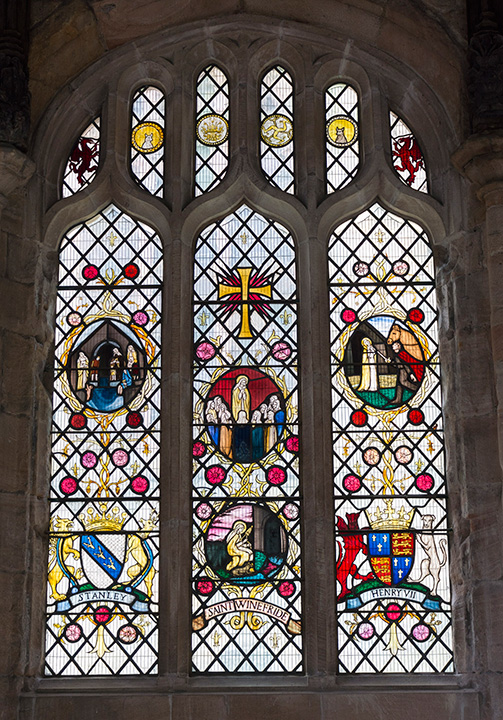
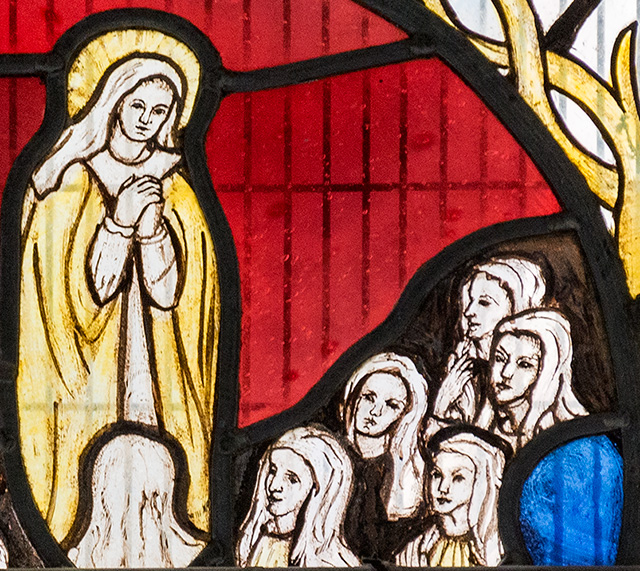
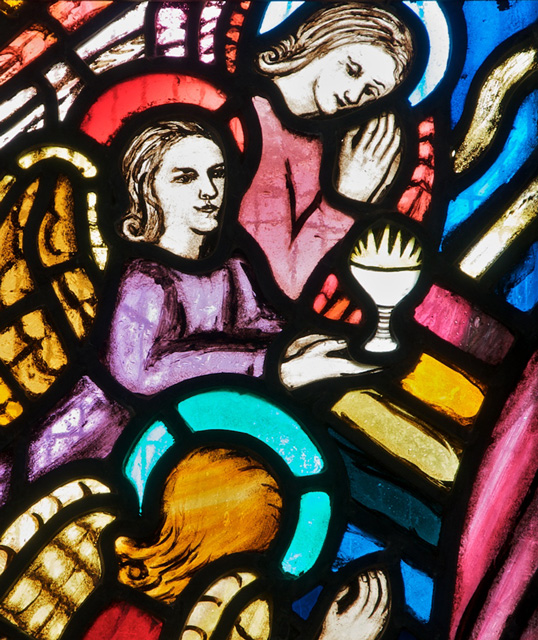
I finally managed to match the style with smaller figures in other works by Joan Howson that I have come across in Wales. Figures of angels in her east window at Llanfihangel-y-traethau, not far from Porthmadog, are very close in style, and there are similarities in the painterly style of the two little windows tentatively attributed to Howson in the church porch at Penmorfa. The redundant church at Penmorfa, now in the care of the Friends of Friendless Churches, is a few miles to the north of Porthmadog, where the artist set up her studio in the late 1950s or 60s. During the war she had been instrumental in bringing young evacuees to Plas Tan-y-Bwlch, near Maentwrog, east of Porthmadog. She also made a window for the church at Maentwrog in 1955, signed with the gull mark of the studio established by her partner Caroline Townsend, who died in 1944.
The windows at Penmorfa were of two Welsh saints, Cybi and Cyngar, and an earlier window by her in south Wales, at Pontarddulais, includes larger figures of more Welsh saints Teilo and Carannog. I was curious as to why Carannog was included in the window, who doesn’t have any local associations with Carmarthenshire or the Swansea area, but the image of the saint is one of only three that I have found in a church in Wales. A further link between Joan Howson and the window in Holywell is that the artist was born in the same county (Flintshire) although further south at Overton, but perhaps she still had contacts in the area. It is possible however, that the Holywell window was not by Howson but by a glass painter who worked with her in her later years in Wales.
Welsh Saints from Welsh Churches – a new book
When I conceived my book Stained Glass from Welsh Churches, it was one of couple of books on art in Welsh churches that I wanted to produce. I had been recording imagery of Welsh saints since about 2002 when working on the medieval material for the ‘Visual Culture of Wales’ project, and aimed to publish a study on this imagery. I was aware of the popular interest in the saints of Wales, although there had been hardly any study of the modern imagery of these saints found across Wales in its churches.
I began to plan the book, write short sections and even draft out some spreads of the book as early as 2010. I decided that the book would consist of an introduction followed by a series of spreads with a selection of images of individual saints.
The choice of cover image was also an early decision, a charming example of a female saint by a female artist and Arts and Crafts pioneer, Mary Lowndes. The window is at the small village church of Cemaes, not far from Machynlleth in Powys, and includes an image of Brochfael Ysgythrog’s encounter with Melangell as she shelters a hare fleeing his dogs. The window is so impressive that I also reproduced a full-page detail of the standing figure of Melangell above the scene inside the book.
I tried to improve on what I felt were shortcomings of Stained Glass from Welsh Churches (2014), which were usually a result of too much material and an attempt to include as many illustrations as possible, while also leaving so much out. The imagery of Welsh saints, although it includes sculpture and other media as well as stained glass, is a smaller corpus and I was able to include large images of impressive details in addition to images showing the saints in context in larger windows (some saints only being found in the small tracery lights of large windows) and with other figures on reredoses and pulpits. These contextual images are mostly found in the introductory chapters.
As the opening section grew (eventually reaching 127 pages and 282 images), I split it into three main sections. It opens with a definition of ‘Welsh saints’, and an overview of what we know (and don’t know) of the cults of saints in medieval Wales. This is followed by a broadly chronological overview of the imagery, and some observations on iconography and how saints were portrayed.
The choice of individual saints (apart from the very first, the two scarcely divisible Roman martyrs Aaron and Julius) featured in the spreads in the second half of the book was based on the sole reason that there were enough images to write about and illustrate. Images of other saints were included in the opening sections where possible, such as Cynhaiarn, Collen, Euddogwy, Maches, Llwchaiarn, Gwenfaen and several of the sixteenth- and seventeenth-century Catholic martyrs, as I only managed to find one or two images of these saints.
Images of some Welsh saints are found across a number of churches, and the two-page spreads were extended to four or six pages for the saints whose imagery was plentiful. Saints whose images I have come across most frequently include Teilo, Illtud, Gwenfrewy (Winefride), Deiniol and David, and the smaller separate book, Depicting St David (2020), was intended to be a supplement to this book with images of Wales’ patron saint. As things worked out it was published a good while previously, and Welsh Saints from Welsh Churches includes a couple of discoveries of images of David that I made after the publication of Depicting St David, as well as others that I set aside for this book and omitted from the smaller volume.


There are plenty of books on saints but I’m not aware of any similar studies of the imagery of a nation’s saints, or of regional saints. The book is an overview, and so many of the windows and other imagery published in the book deserve more detailed study and comment than I have had the space to do in this book.
Spreads from Welsh Saints from Welsh Churches can be found on my website. Visit the publisher’s website to order the book with free postage, or support your local bookshop.
New research, events and publications 2022–3
July 2023
Although the dearth of new material on this blog would suggest otherwise, there have been many events and new publications to report on from the last twelve months or so – but little time to detail them here.
I hope to add some details on these activities and a selection of some new discoveries made while completing Welsh Saints from Welsh Churches, which was published earlier this year. For this book, and a selection of spreads, see this page on my website.
Further articles on the imagery of saints in Wales were published in an edited collection of new writing about saints in Wales in 2022, and a further article on the work of Celtic Studios is forthcoming this year.
There have also been new books on the stained glass in the Welsh port towns of Fishguard and Holyhead. I will try and add the material in as chronological an order as possible, although I may well get distracted by more recent events.

